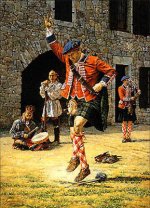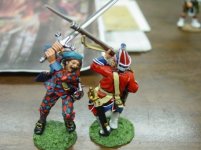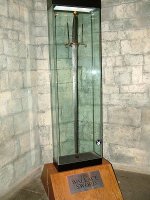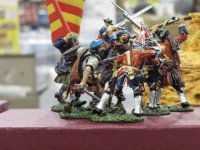You are using an out of date browser. It may not display this or other websites correctly.
You should upgrade or use an alternative browser.
You should upgrade or use an alternative browser.
For the Jacobite Addicts (1 Viewer)
- Thread starter whdamon
- Start date
mikemiller1955
Lieutenant General
- Joined
- Aug 3, 2008
- Messages
- 17,606
If only the Jacobites had dressed outlandishly and drank to excess, they would have struck fear in their opponents.
yea....hehehehe....they wore kilts, played pipes and cleaved heads.
Combat
Brigadier General
- Joined
- Jun 10, 2005
- Messages
- 11,008
Throughout the French and Indian War, English authorities negotiated with the Native Americans for their military assistance. While not as skilled at romancing them as their French counterparts, the English did experience some success, due partly to the influence of the Scottish Highlanders, whom the Indians viewed as being similar to themselves. Both cultures were consummate warriors and lovers of the fray, both had great respect for the orator and Chieftain, and both clan and tribe held ancient traditions in high regard. Their similarities in temperament and philosophy sometimes led the English to refer to the Scots as "cousins to the Indian."
Preparing for battle had its own Highland custom . . . the war dance. Here Robert Griffing shows a soldier of the 42nd Highland Regiment within the walls of Fort Ticonderoga seeking a prophecy by engaging in an ancient Highland tradition. According to clan tradition, if the dancer touches the swords beneath his feet during the dance, it's a forecast of doom for the coming battle. A piper provides the tunes. An Iroquois warrior watches, waiting for the results. An amused and approving smile appears on the face of a tribal headman as he keeps time with his drum.
Preparing for battle had its own Highland custom . . . the war dance. Here Robert Griffing shows a soldier of the 42nd Highland Regiment within the walls of Fort Ticonderoga seeking a prophecy by engaging in an ancient Highland tradition. According to clan tradition, if the dancer touches the swords beneath his feet during the dance, it's a forecast of doom for the coming battle. A piper provides the tunes. An Iroquois warrior watches, waiting for the results. An amused and approving smile appears on the face of a tribal headman as he keeps time with his drum.
Attachments
whdamon
Corporal
- Joined
- Sep 22, 2009
- Messages
- 495
To answer the question...what was the motivation for John to generate the Jacobite series.
It seems when he stated the BOS series one of his goals with the series was to press his sculpting skills, specifically with dramatic anatomical positions. Much to his surprise when starting the sculpting, men on snow shoes have quite a restriction of movement and body part range if they were to keep a proper center of gravity. Hence he realized if his goal was to be met, it would be with another series and so came the Jacobites. Works for me as I can't imagine anything more malformed than a charge of wild eyed Scotsmen. (I can say that as I is one)
It seems when he stated the BOS series one of his goals with the series was to press his sculpting skills, specifically with dramatic anatomical positions. Much to his surprise when starting the sculpting, men on snow shoes have quite a restriction of movement and body part range if they were to keep a proper center of gravity. Hence he realized if his goal was to be met, it would be with another series and so came the Jacobites. Works for me as I can't imagine anything more malformed than a charge of wild eyed Scotsmen. (I can say that as I is one)
mikemiller1955
Lieutenant General
- Joined
- Aug 3, 2008
- Messages
- 17,606
The Jacobites is considered part of the 7 Year War...which was Johns original goal.
It's just obscure to FIW collectors because it's in the European theater.
Either John told me or I read...I don't recall...but it was some kind of test of his skills as I remember........perhaps the sculpting.....but definitely the painting.
The peculiar series is 1812...Chippewa...which I personally love....it's well after the 7 Years War.
It's just obscure to FIW collectors because it's in the European theater.
Either John told me or I read...I don't recall...but it was some kind of test of his skills as I remember........perhaps the sculpting.....but definitely the painting.
The peculiar series is 1812...Chippewa...which I personally love....it's well after the 7 Years War.
PJDeluhery
Corporal
- Joined
- Sep 11, 2009
- Messages
- 586
Throughout the French and Indian War, English authorities negotiated with the Native Americans for their military assistance. While not as skilled at romancing them as their French counterparts, the English did experience some success, due partly to the influence of the Scottish Highlanders, whom the Indians viewed as being similar to themselves. Both cultures were consummate warriors and lovers of the fray, both had great respect for the orator and Chieftain, and both clan and tribe held ancient traditions in high regard. Their similarities in temperament and philosophy sometimes led the English to refer to the Scots as "cousins to the Indian."
Preparing for battle had its own Highland custom . . . the war dance. Here Robert Griffing shows a soldier of the 42nd Highland Regiment within the walls of Fort Ticonderoga seeking a prophecy by engaging in an ancient Highland tradition. According to clan tradition, if the dancer touches the swords beneath his feet during the dance, it's a forecast of doom for the coming battle. A piper provides the tunes. An Iroquois warrior watches, waiting for the results. An amused and approving smile appears on the face of a tribal headman as he keeps time with his drum.
Ya know, I never understood that print until now. Thanks for the information.
mikemiller1955
Lieutenant General
- Joined
- Aug 3, 2008
- Messages
- 17,606
I had made a remark in an email to Aurele (Old Tank) about the huge sword in this Highlander's hands.
He told me it was called a "two handed claymore sword", a two handed sword and had even been used by some of the Scots at Battle of Monongahela.
I looked it up and was amazed at the size of these swords.....
The two-handed claymore was a large sword used in the late Medieval and Early Modern period. It was used in the constant clan warfare and border fights with the English from circa 1500 to 1700. The last known battle in which it is considered to have been used in a significant number was the Battle of Killiecrankie in 1689.[citation needed] It was somewhat smaller than other two-handed swords of the era. The two-handed claymore seems to be an offshoot of Early Scottish medieval swords which had developed a distinctive style of a cross-hilt with downsloping arms that ended in spatulate swellings. The spatulate swellings were frequently made in a quatrefoil design.[citation needed]
The average claymore ran about 140 cm (55") in overall length, with a 13" (33 cm) grip, 42" (107 cm) blade, and a weight of approximately 5.5 lb (2.5 kg), the blades are most similar to the type XIIIa, using the Oakeshott typology.[citation needed] Fairly uniform in style, the sword was set with a wheel pommel often capped by a crescent-shaped nut and a guard with straight, down-sloping arms ending in quatrefoils and langets running down the centre of the blade from the guard. Another common style of two-handed claymore (though lesser known today) was the "clamshell hilted" claymore. It had a crossguard that consisted of two downward-curving arms and two large, round, concave plates that protected the foregrip. It was so named because the round guards resembled an open clam.
He told me it was called a "two handed claymore sword", a two handed sword and had even been used by some of the Scots at Battle of Monongahela.
I looked it up and was amazed at the size of these swords.....
The two-handed claymore was a large sword used in the late Medieval and Early Modern period. It was used in the constant clan warfare and border fights with the English from circa 1500 to 1700. The last known battle in which it is considered to have been used in a significant number was the Battle of Killiecrankie in 1689.[citation needed] It was somewhat smaller than other two-handed swords of the era. The two-handed claymore seems to be an offshoot of Early Scottish medieval swords which had developed a distinctive style of a cross-hilt with downsloping arms that ended in spatulate swellings. The spatulate swellings were frequently made in a quatrefoil design.[citation needed]
The average claymore ran about 140 cm (55") in overall length, with a 13" (33 cm) grip, 42" (107 cm) blade, and a weight of approximately 5.5 lb (2.5 kg), the blades are most similar to the type XIIIa, using the Oakeshott typology.[citation needed] Fairly uniform in style, the sword was set with a wheel pommel often capped by a crescent-shaped nut and a guard with straight, down-sloping arms ending in quatrefoils and langets running down the centre of the blade from the guard. Another common style of two-handed claymore (though lesser known today) was the "clamshell hilted" claymore. It had a crossguard that consisted of two downward-curving arms and two large, round, concave plates that protected the foregrip. It was so named because the round guards resembled an open clam.
Attachments
PJDeluhery
Corporal
- Joined
- Sep 11, 2009
- Messages
- 586
I think the two-handed claymore is perhaps a local version of the German "zweihander" used by the Landsknecht mercenaries at about the same time and also the "Longsword" used in Europe about this same time.
mikemiller1955
Lieutenant General
- Joined
- Aug 3, 2008
- Messages
- 17,606
Thanks for the photo Brad...I wouldn't want to be in that hot and heavy action next to the guy with the big sword.
Jagdpanther
2nd Lieutenant
- Joined
- Jun 17, 2008
- Messages
- 3,154
I seen these in person at the Hackensack show also. I will admit they look really nice. Also I did get a chance to meet John Jenkins.
These pictures of the new Jacobites only prove the JJD is making the best figures on the market. No one else is doing figures with such animation and color. The choice of the '45 was inspired and has been done with such aplomb that everyone else looks like they are standing still next to JJD. Can't wait for his new Jacobites and the new Sudan series to hit. -- lancer
Users who are viewing this thread
Total: 2 (members: 0, guests: 2)





